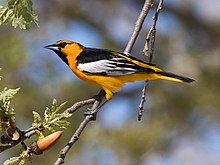Icterid
The Icteridae are a family of small to medium-sized New World songbirds.[1][2] They are usually brightly colored. Most species have black as a main plumage color, often enlivened by yellow, orange or red. The family is extremely varied in size, shape, behavior and coloration.
| Icterids | |
|---|---|

| |
| Adult male Bullock's oriole | |
| Scientific classification | |
| Domain: | Eukaryota |
| Kingdom: | Animalia |
| Phylum: | Chordata |
| Class: | Aves |
| Order: | Passeriformes |
| Superfamily: | Passeroidea |
| Family: | Icteridae Vigors, 1825 |
This group includes the New World blackbirds, New World orioles, the bobolink, meadowlarks, grackles, cowbirds, oropendolas and caciques. They are only distantly related to the Old World common blackbird (which is a thrush) or the Old World orioles.
Icterids are unusual in songbirds because they have considerable sexual dimorphism. For example, the male great-tailed grackle is 60% heavier than the female. The smallest icterid species is the orchard oriole, in which the female averages 15 cm in length (6 in) and 18 grams (0.040 pounds) in weight, while the largest is the Amazonian oropendola, the male of which measures 52 cm (20 in) and weighs about 550 grams (1.21 pounds). This variation in size is greater than usual in passerine families.
One unusual adaptation shared by the icterids is gaping, where the skull allows them to open their bills strongly rather than passively. This lets them force open gaps to get at hidden food.
References
change- ↑ Lowther P. 1975. Geographic and Ecological Variation in the Family Icteridae Wilson Bulletin 87 (4): 481-495
- ↑ Parkes, Kenneth C. 1991 in Forshaw, Joseph (ed), Encyclopaedia of Animals: Birds. London: Merehurst Press, pp. 214–215. ISBN 1-85391-186-0